Suffering: 1) To feel pain or distress; sustain loss, injury, harm, or
punishment.
Introduction
Those diagnosed with Multiple Sclerosis certainly
understand this definition - indeed, they live it. And yet many provide an
example for the rest of us to learn from. This year, I learned. Again.
My wife Claire has had MS for nearly 18 years now. As a
very accomplished and hard working professional violist, her career was taken
from her by continuing nerve damage in her hands and arms. After a heartbreaking
transition period, she managed to let go of that passion for playing and move on
- on to creating and enjoying a family with me, writing, and living life to the
fullest.
What would any of us have done, faced with this loss?
Perhaps given up, perhaps set new expectations low enough to be met. Yet what is
the response we would want to have, the example we would wish to set? To choose
to live - not just physically but wholly. This is the lesson I have learned from
Claire and so many others who live every day with MS, who make the choice
- every day - to make the most of what they have. It's a lesson that bears
repeating, and though it may be muted in the description of a bike ride you're
about to read, it is no less with me today.
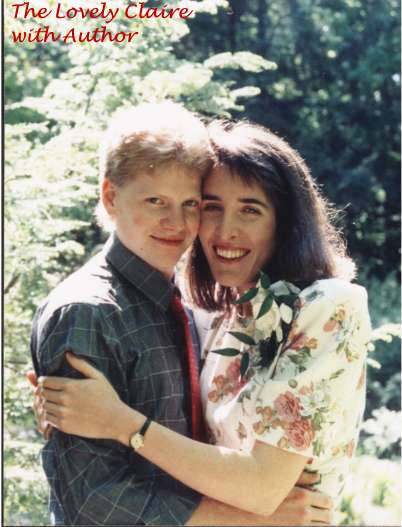
The Y2K MS150
The MS150 is a two-day, 150 mile benefit ride for the National Multiple
Sclerosis Society. The ride this year was based in Corvallis, Oregon, starting and
finishing on the Oregon State University campus. Though the numbers aren't in yet, it looks as though a new fundraising
record will be established. The funds raised go to the National Multiple
Sclerosis Society, Oregon Chapter, which uses them to provide medical equipment
to MS sufferers, fund research to discover treatments and cures for MS, and
provide support groups and education to area residents who have MS.
The aim of this account is to give those generous people who sponsored me a
"view from the saddle" by one of the nearly 500 people
participating in the ride. So clip in1 and read on!
Saturday, August 5
It was a cool Saturday morning, relatively speaking, as I found myself driving
South on I5 from Portland to Corvallis. Though long rides are nothing new to me,
I found myself wondering how I would perform - would I push too hard and burn
out? Ride conservatively and spend too many hours in the saddle? The questions
were due to the level of preparation achieved by early August. Time is certainly
not in surplus for our family right now, with 3 and 23 month old brothers reigning
in our home. The odd weekend century2 is a thing of the past for the time being,
and training rides are limited to short, intense, hilly rides before work or
during lunch, with a very occasional longer ride on weekends. Thus my
apprehension - in the past I have always known what my limits were. This year I
was not so sure.
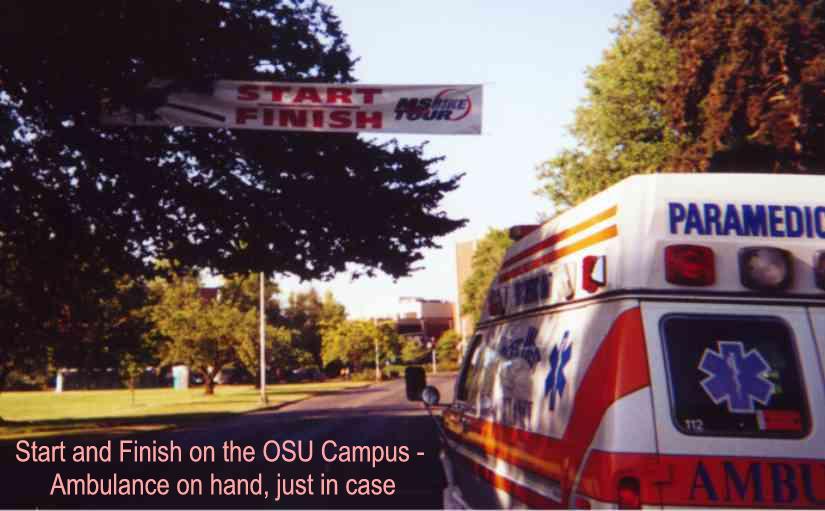
In this state of mind I reached the OSU campus. The temperature was now mild,
in the mid sixties, and the sun was out. The excitement of the ride was sinking
in, and I left my worries as I left my car to check in. At the table, volunteers
had release forms to sign, and they handed out packages including rider numbers to
identify us on the road, T-shirts, etc. Pledge sheets were due, and I was happy
to turn mine in with over $1,500 in pledges. Again I must give thanks to all
my sponsors, whose generosity merits special mention. Thank you all - you have
made a difference!
It was time to begin the ride. At 8:40, most of the riders had already left,
so the start was a solitary one for me. Concentrating on warming up slowly,
keeping an eye out for course markers, and checking the bike for any anomalies
occupied the first several miles of the ride. Soon enough the muscles were warm
and the coffee was working it's magic. I found myself rolling along at a
satisfying pace through gently rolling farmland. Fourteen miles into the ride came the
first hill, a short, mild climb along a quiet, tree-lined country lane. Being
light and on the small side, my body is well suited to climbing. Indeed, I enjoy
it, and found this part of the ride refreshing. Rest stops #1 and #2 appeared
and disappeared, not needed so early in the day. Rest stop #3 was a water stop,
and there I paused to stretch, drink, and eat part of an energy bar.
Riding again, I reflected on Lance Armstrong, cancer survivor and winner of
both the 1999 and 2000 Tour de France, who once said "the best cyclists are
the ones who can endure the most pain." This was an epiphany for me when I
read it. I realized that rides like this can't be done without pain, and so
challenged myself to go that extra 1-2 MPH. It was fear of pain, not the pain
itself that had been holding me back. This "new" philosophy was reflected
now on the computer display - 38 miles, 21.4 average speed, heart-rate in the
upper 160s. Pretty good for a lightweight cyclist riding mostly on the flats
without a pace-line, and I felt no horrible pain or overbearing fatigue. I was
riding harder than I would have in the past... the only danger now being
burn-out.
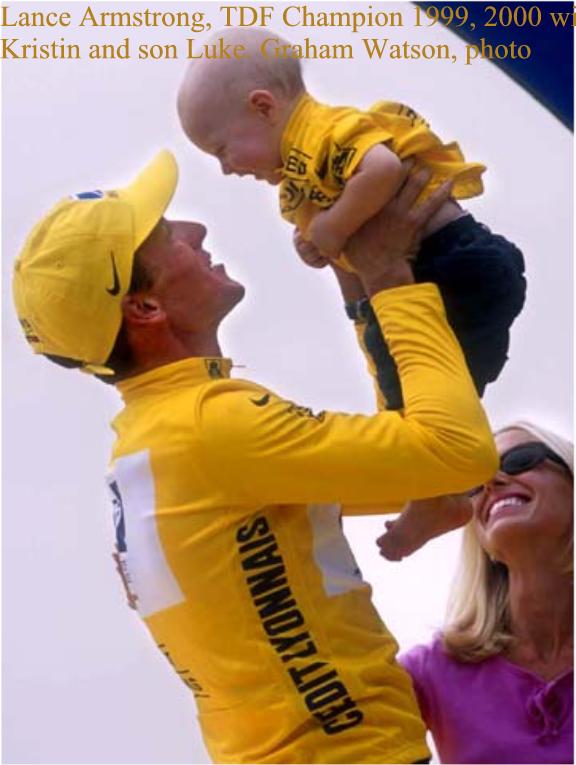
These thoughts drifted in and out of my mind, mixing with images of farms
planted rich in corn and wheat, the smell of freshly turned hay, friendly
greetings exchanged with other riders, and several more hills to climb. It was
lovely, and on top of all that it was the section of the ride leading to the
lunch stop. Now rather hungry, I stopped and ate a sandwich, a boiled potato, two
bananas, and carrots, washed down with large quantities of water. Stretching was
also mandatory, keeping the large muscle groups warm and ready to perform again.
After lunch, the riding was very flat. All around us was farmland, cut
through with 2-lane country roads and dotted with barns and small farm houses.
Many locals were out working, and were likely amused by our parade of
lycra-clad-human powered machines. I was finding it less amusing as time wore
on, however.
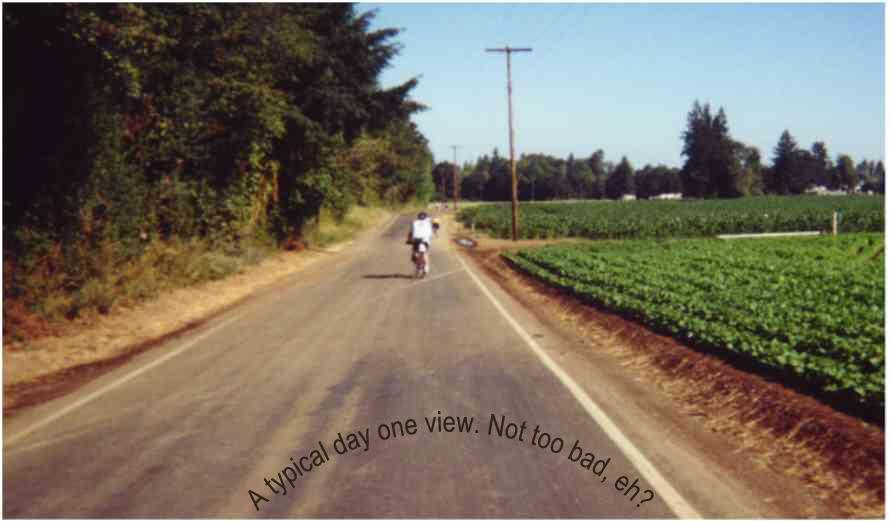
There are two times when you know you can and will finish a long bike ride.
One is in the first 10 miles, after warming up and steeping in the excitement of
the challenge. The other is in the last 5 miles, when no level of exhaustion is
sufficient to knock you off the bike in the following 20 minutes. The vast
majority of a long ride is spent between these two markers...
After mile 50, the wind picked up, blowing at perhaps 5-10 MPH.
Unfortunately, it was a headwind. A mild headwind can easily take 1-3 MPH off
one's speed, and stiff headwinds rob much more. This was not a strong wind, but
after 50 miles of riding and with the temperature picking up, a headwind of any
magnitude was depressing to me. I watched my speed hover around 18 MPH while my
exertion level felt like I should be riding 21-22 MPH. Suffering, I
thought, this is suffering. But compared to what Claire lives with, this was
nothing. What Lance went through? A universe separates their experiences from
mine. Yet
suffering is not relative, cannot be. All I knew was my legs couldn't push any harder, my arms and neck strained to
hold up my head, and the dull ache of muscle against machine would be with
me for the next hour or more - an eternity.
In this dream-like state of mind, the miles continued to roll, and soon my
self-pity began to fade as I reached the outskirts of Corvallis. A circuitous
route brought the cyclists back down to the main campus building for the finish
line. A handful of people clapped as I rolled in, and post-ride conversations
revealed that I was only the 8th or 9th person to finish. Reflecting on the
ride, I realized that no one had passed me, and that I was actually one of the
faster riders on the course, which made me feel better about my
"dismal" performance in latter 1/3 of the ride. No, speed isn't
everything. But meeting a goal and rising to a challenge has meaning for me. I
felt I had done my best and given my all. And that was only day 1!
I arrived home to a wonderful surprise party being prepared by Claire and my
good friend David, with a little help from young Joseph. Gorgeous roses - grown
by Claire - filled
the house, and a sumptuous meal of spaghetti with Claire's famous gourmet meatballs, salad, fresh garlic bread, and coffee ice cream capped a meaningful
day and wonderful ride with an outstanding culinary experience shared by
family and friends. Thank you Claire!
Day 1 Stats
|
Distance
(miles) |
81.33 |
| Total Time |
4:41:22 |
| Riding Time * |
4:17:06 |
| Average (MPH) |
17.45 |
| Rolling Average (MPH)* |
18.9 |
| Maximum (MPH) |
37.5 |
| Average Heart rate (beats/min) |
164 |
| Estimated calories burned |
2,194 |
| Elevation gain (ft.) |
1,967 |
* These are the ones that count
Sunday, August 6
Day two started out the same, driving South from Portland to Corvallis. An
earlier departure from home lessened the rush, but I5 has a way of coaxing up
one's speed. I made the 80 odd miles to the start in just over an hour,
providing plenty of time to start with the main group. Again the sunscreen
ritual was performed, quick adjustments were made to the bike, and a few photos
snapped for the report, then we were off. Saturday's route had taken us on a
Southern loop from Corvallis - today's route was to follow a Northern loop. The
terrain North of Corvallis is hilly, though not mountainous, therefore we could look
forward to a more challenging ride Sunday. Before relating the actual ride,
let me tell you what I know about climbing:
 | It takes practice to know just how much effort is needed to climb a
certain grade of hill. |
 | Practicing on steep hills makes not-as-steep hills easier to ride. |
 | "Small" framed individuals generally are better climbers,
because they have less mass to carry up the hill. |
 | Climbing is what makes or breaks a race, or a recreational ride for that
matter; riding up a hill at 12 MPH instead of 10 will put a rider much
farther ahead than descending at 37 MPH instead of 34 (delta V of ~17% in
the former case versus ~8% in the latter). |
 | There is a good deal of psychology that goes into learning to climb well. |
 | When fit, I can climb for about 6 miles with my heart rate between 175 and
185 beats/minute; 15 miles or more with my heart rate between 165 and 175. |
After a modest start at just after 8am, the course snaked from the OSU campus
to the West and North. Overall we were going up, but not too drastically until
mile 10. At that point the biggest climb of the ride loomed in front of us - 5
miles with a vertical gain of over 1000 feet. That works out to about a 4% grade
overall, but it varied from almost flat to 7% or so. It doesn't sound very
steep, yet after 3 or 4 miles of climbing, and given the 82 miles ridden the day
before, it began to feel steep. The scenery helped - rolling hills, fir forests
of varying ages, and several beautiful views helped us all up those hills.
The actual climbing was hard, despite the fact that the grade wasn't very steep. On
steep climbs, I "let" myself use lower gears and go a little more
slowly, but on moderate climbs I seem to feel I should be able to ride faster
than I am. So I push the tallest gear manageable while keeping my
heart-rate in check, and this climb was high effort, alternating seated climbing with out of the saddle. I kept the speed up around
13 or 14 MPH, and found myself passing a lot of people. At one point a woman
said "Jesus, look at that guy" to her friend just after I passed her! I was
feeling smug until I noticed a cyclist in a yellow jersey gaining on me as we
climbed. Maintaining my pace, he was with me most of the climb but in the last
200 meters or so he dropped back by several bike lengths. For perspective, a
hill like this would likely be climbed at around 18-20 MPH by the Tour De
France peleton (if they weren't chasing a breakaway), lest anyone get the idea
that I think I'm all that great. In fact, any decent Category 4 racer would
easily out climb me on this or any other hill. I'm just faster than the average
recreational cyclist.
This fun, effortful climb was followed by a long, straight descent into a mostly
undeveloped valley. It was nice, but not steep so not particularly thrilling.
Following the descent the course gained back another 350 ft in elevation, then
descended again to the third rest stop at mile 26.
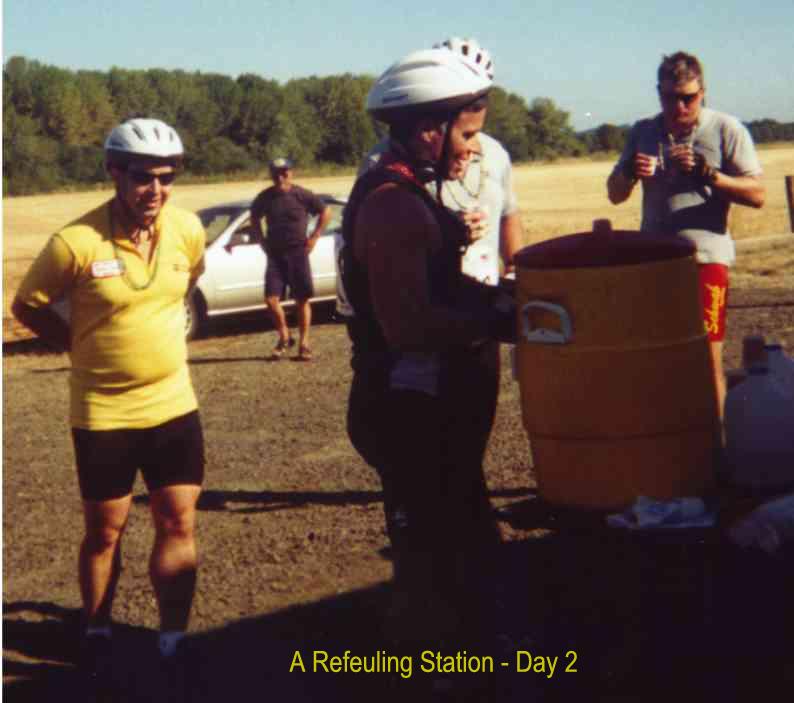
I stopped there, since I had
skipped the first two (I didn't even see the second one) to eat a banana,
stretch, and refill my water bottles. There were 11 miles left before lunch, so
I made the stop short and got underway again. Through rolling farmland this was
a section that found me riding in a rhythm, not paying very much attention to
anything other than keeping the pedals turning. That mode of riding, mind
wandering, just being on the bike, was very enjoyable. Lunch arrived
quickly and was a welcome stop.
More fruit, a veggie sandwich, water, and 1/2 of a Power Bar was enough for
me, and after a quick call to Claire to update her the road was once again
rolling underneath my tires. The post-lunch ride continued through rolling
farmland, but the road surfaces were now the infamous "tar and gravel"
that rural Oregonian planners are so fond of. It's a rough surface that robs
momentum by bouncing the wheels up and down, and I generally dislike it a great
deal. However, this year I was riding my new (to me) bike - a titanium Litespeed
with carbon-fiber fork - which somehow didn't feel as uncomfortable on the rough
surfaces as my previous steel framed bike. What did
feel uncomfortable was the amount of effort I needed to keep my speed up.
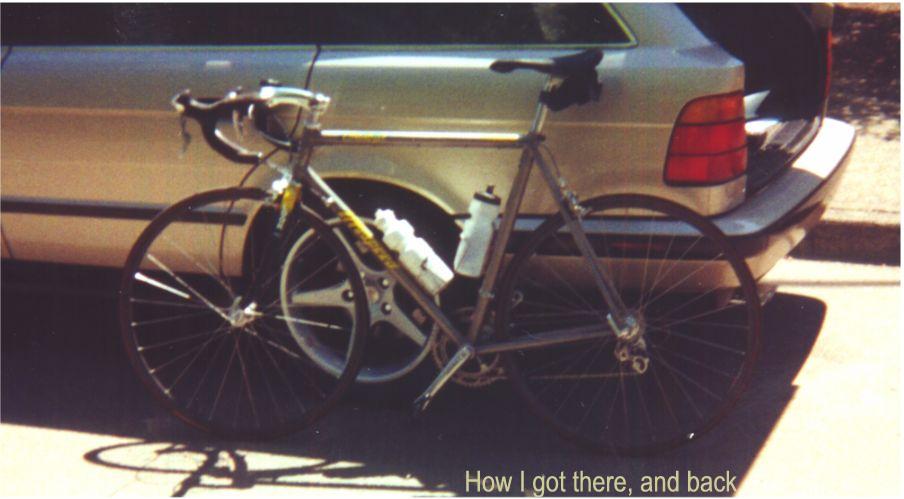
(Finally, some real shots of the steed!) 
By now, mile 50 on day two, and mile 130 for the weekend, my legs were
definitely tired. At the non-staffed rest stop at mile 52, I pulled in just as a
woman was pulling out. I ate another Powerbar, drank more water, and stretched
extensively to try to get more blood into my muscles. Starting out several
minutes later, I felt fresh and strong for about 2 miles, then that
"dead" muscle feeling was back. Resigned to hobbling back, or so it
felt, a depression set in. But then, on a very long straight away, I caught
sight of the woman from the last rest stop. Now there was a challenge - to catch
up with her (she was probably close to a mile ahead). This section of the course
was flat, so I shifted to a larger gear than I wanted to spin and started
increasing speed slightly. 19... 20... 21 was the highest speed manageable in my
current state. Slowly the distance between us shrank, but it was a good 20
minutes before I finally pulled along side her and the recumbent (see photo
below) rider she
had just caught up to.
We chatted for a while, and I learned that Walt, the recumbent rider, had
taken a wrong turn somewhere and missed lunch. He was back-tracking to make sure
he got the full 77 miles for the day, and warned us that there were more rough
roads ahead. The woman was from Eugene and was a
very strong rider. She was riding for the challenge and for the cause, and I
admired her devotion.
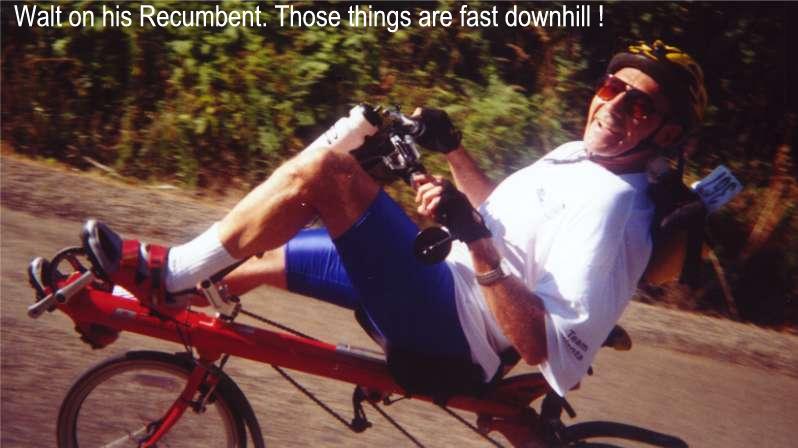
After a mile of chatting, I was ready to ride a little harder again, so said
farewell and continued my ride at a faster pace. The terrain began to be
interrupted with a few little hills, short "rollers" as we cyclists
call them. Now the real way to ride rollers is to increase effort in
order to keep the speed up as you climb. Since they aren't long hills, and
recovery can be done by backing off after cresting, this is really the most
efficient way, unless you want to be on the bike all day. You don't shift down
unless the hill is long or steep. We cyclists call that "hammering
rollers." At that point in the ride, however, I wasn't in a state to hammer
anything, much less a series of short hills comprising an overall altitude gain.
So, I shifted down when my legs refused to push any harder, and rode more
slowly.
I was at mile 58 or so, and began looking for the last rest stop due at mile
66, as I badly wanted to stretch and take a little rest. Since the ride was
seeming longer and longer, it was torture to watch the miles tick slowly by, I switched
my computer to display estimated calories burned instead, assuming the rest stop
would be obvious. However, since there were only a handful of people on the
course ahead, the rest stops later in the stage were not yet staffed. What that
meant was that the usual cheering and encouragement that marks a rest stop wasn't
there to clue me in to where the actual rest stop was. I missed it,
verified by a
check of the odometer which showed 69 miles.
So continuing the ride was the only thing to do. In those last 8 miles there
were more rollers and a couple of fairly steep 1/4 mile climbs that I struggled
up. At last the outskirts of Corvallis sprang up around me, and I knew I would
make it. The last 3 miles were agony but since there were only 3 miles, adrenaline
for the finish kicked in. The only place for the nervous energy to go was
through the bike onto the ground in the form of heat from the friction of the
tires rolling along the road. That is to say, I hammered the last 3 miles though
my whole body protested vigorously. The final sprint to the line was cruelly
interrupted by a red light on a cross street, but the satisfaction of completing
the ride was not diminished. At the finish, volunteers cheered as we crossed
through the arch of balloons, and the finish line party was being setup. This
day I finished in the top ten, and I was very happy to have maintained my effort
through to the end.
A garden burger, change of clothes, lots of water, and some fresh fruit later
I was back in the car heading for my wonderful family. This had been another amazing MS150
(well, MS158 actually)!
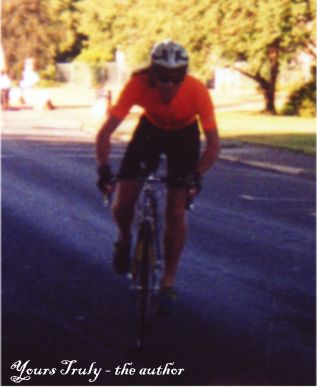
Stats, Day 2
|
Distance
(miles) |
77.0 |
| Total Time |
4:21:22 |
| Riding Time * |
4:09:15 |
| Average (MPH) |
17.75 |
| Rolling Average (MPH)* |
18.6 |
| Maximum (MPH) |
37.1 |
| Average Heart rate (beats/min) |
155 |
| Estimated calories burned |
1,984 |
| Elevation gain (ft.) |
3,319 |
Overall Stats
|
Distance
(miles) |
158.33 |
| Riding Time * |
8:26:21 |
| Rolling Average (MPH)* |
18.75 |
| Maximum (MPH) |
37.5 |
| Average Heart rate (beats/min) |
157 |
| Estimated calories burned |
4,177 |
| Elevation gain (ft.) |
5,286 |
* The important ones
Postscript
To see others who don't have direct contact with MS out riding hard and
raising money to help those who do is an inspiration. The volunteers and MS
Society employees who spend so many hours making this ride possible certainly
deserve special recognition. Thank you NMSS, fellow riders, and volunteers!
For me, so close to the disease, motivation for this ride is very strong.
It's cathartic to be able to translate physical action - in this case riding a
bike - into the fight against the MS that Claire must grapple with. Claire does
this same thing in large and small ways every day. She swims 3-5 days a week to
keep fit; eats a well balanced diet (and helps the rest of us eat well too!);
gardens for stress relief; and takes care of our two boys
for several hours a day. While this ride happens but once a year, Claire performs the acts to rise above her disease
every day, and serves as an inspiration to me and many others.
Footnotes:
1)
"Clip in" is the act of engaging the cleat and binding system on
modern bicycle pedals
2)
Century in bicycling terminology means a 100 mile ride
|